
When to Use “That” vs. “Which” and the Clauses They Introduce
The rules for understanding the different uses of “that” and “which” are relatively straightforward, in that any defining clause requires “that,” while any non-defining clause requires “which.”
Which vs. that
The rules for understanding the different uses of “that” and “which” are relatively straightforward, in that any defining clause requires “that,” while any non-defining clause requires “which.” The complicated part is knowing the difference between defining and non-defining clauses.
When to use that or which
How to use “that”
Defining relative clauses, also known as restrictive clauses, provides us with the necessary information to identify the subject we are talking about. If we remove the defining clause, the sentence's meaning drastically changes, and we are unable to identify the particular person or thing that we are talking about.
Cats that chase mice are good hunters.
If we remove the defining clause, “that chase mice,” then we are left with a bold statement that cats are good hunters. This is grammatically correct and may be true but extremely vague, as the group of cats we originally referred to is no longer specified.
Examples:
The iPhone that was released recently is very expensive.
The movie premiere that I told you about is tomorrow.
My sister has found the earrings that she lost last week.
How to use “which”
A non-defining relative clause also called a non-restrictive clause, adds information to the sentence, but that information doesn’t define what we’re talking about. Let’s take an example sentence:
My house, which overlooks the river, is on a hill.
If we remove the non-defining clause inside the commas, then it is still a sentence informing us that the house is on a hill.
Non-defining clauses always use the relative pronoun “which” rather than “that,” but depending on the subject could also use who, whose, whom, or where.
Examples:
I gave her a box of chocolates, which contained all of her favorite flavors.
New York taxis, which are yellow, are easily recognizable.
Plastic water bottles, which take hundreds of years to decompose, are polluting the oceans.
If we remove the non-defining clause from these examples, the sentences are still complete.
That or which: conclusion
You may have noticed that in both spoken and written language, “that” is more common and sounds slightly more informal than “which.” As we have seen, this doesn’t mean that they should both be used in the same way. Try to think about the type of clause that follows, and that will tell you which relative pronoun to use.


















